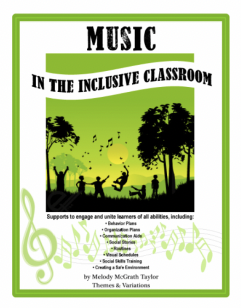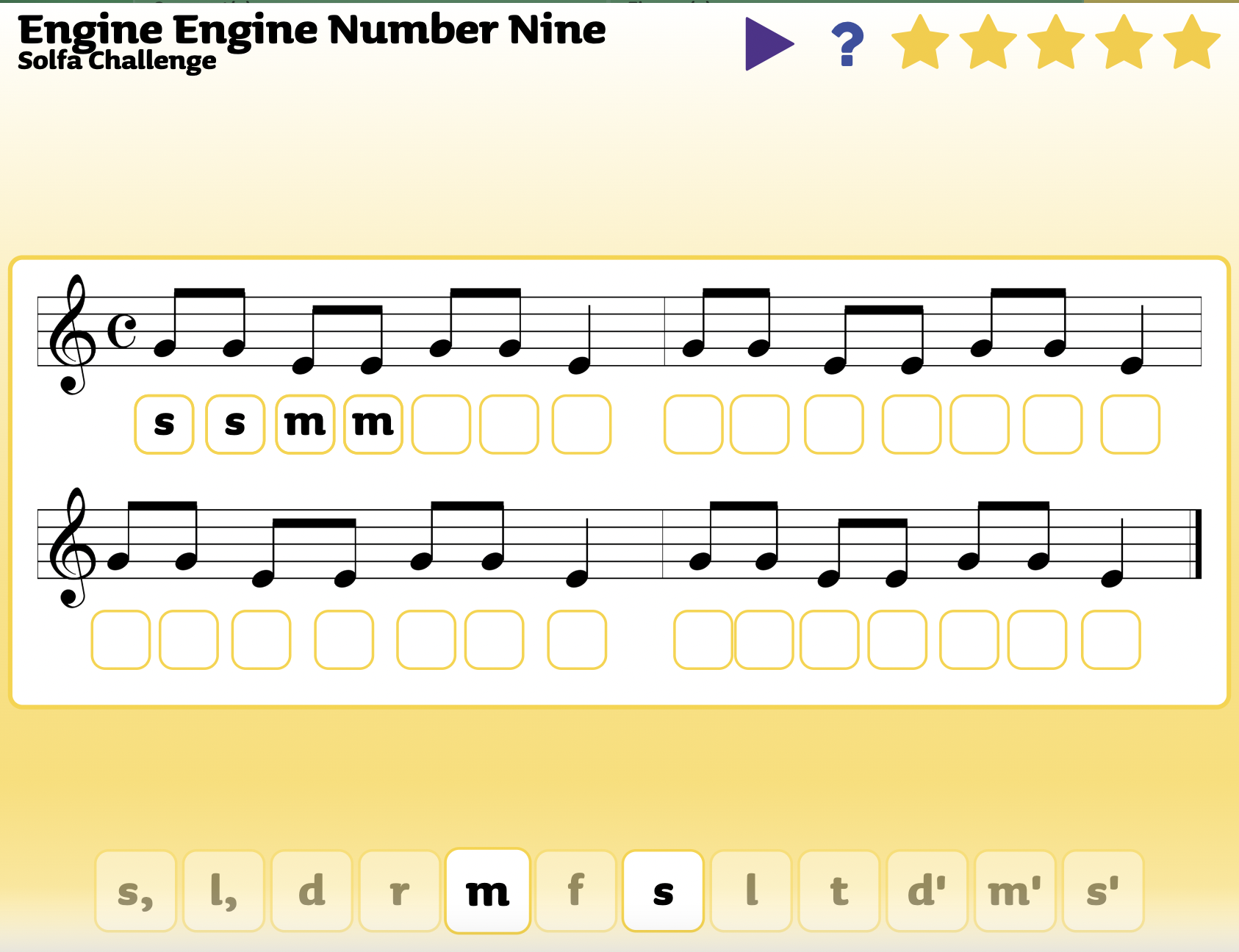Managing Tough Classes

This was posted in our Facebook group this week, and there were many teachers who are in similar situations and posted suggestions. So - thank you to all who posted in the Musicplay Teacher’s group on Facebook - you’re the authors of the Musicplay newsletter this week.
Original Post: I am looking for tips and ideas for my grade 1 music class. The class has many high needs, including a few rowdy behaviour coded boys, and in general the whole class is very high energy, chatty, and all around crazy most days. I feel like I am at my wits end with them. I have tried many different strategies and ideas but every class is literally a zoo and when they leave, I am left feeling like a terrible teacher. I have talked with their classroom teacher and she said she often feels the same way, but gave me a few suggestions. They seem to work better for her though, being that "in class" is a lot more structured than the typical music class. I know music is more of an unstructured setting than the regular classroom, but I am having a hard time figuring out how to still expose them to all the experiences of music. I've tried to stick to a routine with them, but it's difficult as most days I am literally putting out fires and keeping the peace. I do have an EA that comes in with them to help, but she works specifically with a severely autistic boy who often needs to leave the class due to noise levels. I want them to have fun and exciting musical experiences, but I pull out something like egg shakers and it's becomes a room with egg shakers being thrown at each other's heads, and I pull out rhythm sticks and they turn into swords. I feel like despite the chats before on what we will do with our instruments, and even taking the instruments away from kids who aren't listening and using them properly does nothing. Even singing basic simple and fun song games and adding movement turns into mayhem. Does anybody have any tips or suggestions because right now I feel ready to try anything that may work.
This first reply really resonated with me. When you have those extremely tough classes, you have to teach them to behave before you can teach them music.
Sabrina A. B. You will be a lot less stressed and happier if you redifine your role as teaching kids not teaching music. You must teach them how to behave before you can do any music. I have had groups in k or 1 that hardly learned any music that first year... but now that they are older we actually do music more because they can behave. You can use music games and instruments to help with behavior of course... sometimes as a reward sometimes as a teaching tool. I have modified that Mr. Troll bridge song from Musicplay with colors to have an added rule that you only get to stay across the bridge if you keep sining and have appropriate behaviour for example.... they love the idea of winning. You will feel more accomplishment if you make your lessons centered around behavior goals than music ones. And trust me the music comes.... 2 years later I have a class that I had to do this when they were younger with that is now singing two part harmony for the lion king musical and who
Many teachers spoke about the benefits of routines and seating plans. Again, I think this is very good advice:
CM Routine is paramount. Be consistent. It may take 6 weeks or so but it is key I believe. Move quickly from one concept to another. Have Mvt songs ready to interject whenever necessary. As for instruments....I wouldn't use them. Body percussion would prob be best. I also have had my rowdy classes do 10 deep breathes at the start and end of each class. Good luck
Annie D. I've taught (and still teach) similar types of classes. Seating charts and routines are a big help. I start every class the same with a low-key singing attendance (hello Samantha, hello Miss D). I also go back and forth between echo songs from 1,2, 3 Echo songs as well as Movement Songs Children Love. I try to use one of those songs for a reward (if you have a good class we'll do Elephants Have Wrinkles).
Carolyn C.B. Do your kids sit on chairs, risers, floor? I use chairs for all ages, and every class sits boy/ girl/boy etc. I always use the same opening warm up as I believe it's good to establish a routine. ( right now my warm up is "Standing like a Tree." The kids like the movement and it is short.) then I always do a short piggyback song of some sort to mark a holiday, season, etc. I move quickly from one routine activity to the next, and usually by then, I have most kids engaged. I do the "meat" of my lesson then. I know some groups can be incredibly challenging. I agree that moving along quickly, having routine, no instruments, would be where I would start. And then, it may sound weird, but when I feel I'm losing control, I sometimes change my voice to an accent or strange pitch, and they begin to pay attention again. I have few inhibitions so for me, I'm fine with being weird. Anything that works! Good luck.
Cathy L. Use a seating arrangement. What I did with a class that I had trouble with is I gave good behaviour slips to them when they were on task. They were just slips of white paper. Some students would get many in a class. At the end of class they would put their names on them and put in a box. At the end of the week I would pull out 4 or 5 names. They got to pick out of a goodie box for me. It worked very well. I try not to do extrinsic awards but it worked for this class
This Seating Plan Game is a fun twist on the seating plan!
Jill M. With all classes I assign a seating plan - the children sit in 4 - 5 rows and the first lesson is learning where you sit! We play a game, and these are my directions: 1) look on either side/back and front of you and notice who your new neighbours are 2) stand up, take 3 tiny steps sideways, 5 zigzag steps, 4 huge slow steps, 11 teeny tiny steps in any direction, close your eyes, hop up and down twice etc etc etc. 3) on the sound of my chime go back to your row as quickly and quietly as possible. The first row to all sit quietly in proper order is the winner. They love this! We play it 2 or 3 times for a couple of lessons until they know their places. Rules are: no touching, talking during game. They learn their places, and also learn that listening attentively and focussing on my directions can be fun! And of course seating positions are assigned strategically so that chatty friends are far apart, restless students sit on the end of rows to allow wiggle space etc. Just one small game, but has been useful.
Some teachers had suggestions specific to the child with autism.
Becky S. Get your Autistic boy head phones. Make them move non stop. Play statue game. Denise Gagne movement CD. Themes and variations. Even if you see a few move, just keep them in, At the end of game reward those still in. I have a class like this. The more they move, dance, walk, jump. keep beat to any music they are happy and on task. Then, they can sit a little bit and I have to get them up again. Those who don't listen make them sit down. Just keep playing game s. Then stop and praise those still in. Keep doing super fun things. If it's not going well now, it's worth a try to spend a couple weeks doing something else. Those sitting out are going to get sick of watching. Give them a chance to come back, if they are out again, no second chance. They need to know you are in charge.
Jen N: Sounds like you need to start over and reset (I'm sure you've tried). I've had classes just like this and it's always 1 step forward and 10 back. Lol DI music until procedures are set. Noooo instruments until they listen. 1. Your boy with Autism is your first priority. Slide him in with a quieter class for now. If he's in gen ed, I suggest switching classes altogether because he will not find success with this class. 2. Establish sitting behaviors for now, because they don't understand body control. Play some rhythmic patting games, open with songs you can sing over and over. 3. When you feel confident with their behavior and listening (after a few weeks), attempt 5 minutes of EASY standing movement. Reward them with praise. Increase the standing movement time incrementally over weeks. 4. Begin to add instruments. The MINUTE someone uses instruments incorrectly, take them away matter of factly (no emotional response). If it's multiple kids, then the class isn't ready for instruments and they might not ever be...and that is totally ok. Instruments...SMALL periods of time so they can have success. Short 5 minute activities then put them away before
 Music in the Inclusive Classroom by Melody Taylor has additional suggestions for including children with autism in the music classroom.
Music in the Inclusive Classroom by Melody Taylor has additional suggestions for including children with autism in the music classroom.
Music In the Inclusive Classroom
Some form of positive reinforcement may be helpful. Teachers mentioned using stickers, point systems, Class Dojo, and extrinsic rewards. (occasionally)
Melissa H: I had a class last year like that except I had 43 at once, I was teaching two classes at once. It was brutal. My saving grace was positive reinforcement. I had stickers that I handed out randomly throughout the class to good listeners. The students who struggled responded well and wanted one. I also kept a list of prize box students on the board. I didn't do it every class but randomly. This worked wonders and I'm doing it again this year with the same class.
Stacy C: I've been there and it's tough! - I always have assigned seating in my classes and seating charts for myself to look at. When you teach 520 kids a week its challenging to remember all the names. I find when you know the names it makes a big difference. - I use a point system in my classroom. With most of my classes we simply discuss at the end of class how many points they should get. With my tough classes they get points along the way (1 point for walking to music quietly, another point for quiet transitions, etc.). - With my younger students I select a musician of the day. They get to go first for instruments and games. I select a student who shows me they are ready to sing and learn in music class (sitting up straight in their music spot, eyes forward). - For instruments I do Denise Gagne rule "If you play before I say I take your instrument away". I also try "The Secret Code Word" approach. Students have to listen for the secret code word which is "Ready Position" to pick up there instruments. I try to trick them by saying "pick up your instruments" or "ready to play". We practise this A LOT and I always joke with the kids and mention who my "top secret music agents" are. I say to the students our code word is so secret that even their home room teachers wouldn't understand it. They like that its our own little secret! I got this idea from a local teacher here in Calgary and it has been really fun!
Lori B. V. Along with everyone else's comments this tool works sometimes. Www.classdojo.com
Many teachers suggested limiting the number of students who get instruments to help maintain control. I’d like to add my favorite instrument activity when I give out instruments - very effective way to get students watching and listening. (from Rhythm Instrument Fun, and is also in Musicplay PreK)
Play the instruments Chant:
Play the instruments quickly, quickly, quickly.
Play the instruments quickly, quickly, stop!
Play the instruments slowly, slowly, slowly.
Play the instruments slowly, slowly stop!
Play the instruments quietly, quietly, quietly
Play the instruments quietly, quietly, stop!
Play the instruments loudly, loudly, loudly,
Play the instruments loudly, loudly stop!
Kim K. H. I love using small percussive instruments but only hand out maybe 3 at a time to the kids who can handle the activity. Then I hand out one or two more and do the activity again. Pretty soon those that don’t listen clue in that they don’t get the instrument without proper behaviour. Maybe worth a try, but I do feel your pain. Hugs.
Phyllis M. Have 5 or 6 kids play instruments in front while the class sings the song. Then, have another group come up front. Model proper instrument playing technique before the first group comes up and reteach when and where necessary. Every child gets to play an instrument.
Aleksandra G. H. Yes, been there last year with one KG2 class. Tolerated it for months and then it was enough! I pulled out my most interesting instruments, put them in a circle and said: "We are going to practice patience now. I will give this wonderful instrument to the one who can put it in front of himself/herself and just look at it, not touching it. If you can do it for some time, then it's yours to play, along with me on the guitar. Who would like to try?" I would choose only two-three best children and we would all sit and watch those instruments. After a minute or so staring at it, I would let them play. If they touch it - I take it away. More and more children started practicing patience. It worked!!!
Kathy D I have puppet friends who whisper to me. They only come out when it is quiet. Finger puppets are little and like small instruments/high sounds. Bigger puppets like big instruments/ low sounds best. The puppets have favorite songs, games, instruments, music that they want us to play. They pick kids who are doing their best to play instruments and be song leaders, etc. Eventually puppets and instruments get passed to keep beat or play special rhythm. That bad kid has to sit out...until ready to try again. Good luck!
Kristi K. Limit their choices. Movement in place. I may have an un- pitched percussion lesson planned, and they see the instruments, but I am up front, "If you do not keep a level one voice and follow directions, we will not do instruments" , I hold them to it. And if we do start the instruments, and the students lose it, it starts with individuals sitting out and instruments removed. "if your instrument can't be quite, it has to go back into the bag..." and in extreme case, all go away. Consistent, and don't worry it seems "harsh". They understand the clearest black and white requirements at this young age. I find on
Time Outs may be necessary for disruptive behaviors.
Susan F. T. I have seating arrangements for all classes, boy-girl. I start with a sitting or calmer activity and save the moving and instruments for later. If the class doesn't behave, then they don't get to do the "fun stuff" as I call it. I tell them if they want to be able to play games and instruments they have to be able to control themselves. I send kids to a timeout spot away from the other kids, and then after 5 min or so, ask if they are ready to rejoin us. They usually have to miss out on something fun when they are in timeout. We have 2 rules for instruments: 1. Keep it quiet until time to play. 2. Play it right. I tell them that playing instruments is a privilege and we will leave them on the shelf if they can't follow the rules. I try to be positive in the way I approach problems, but sometimes that doesn't work, so do what you gotta do!
Jenifer F commented that keeping your own voice low and calm was successful. I remember Lois Choksy saying, “A quiet teacher has a quiet class.”
Jennifer F I have a class like yours, and their classroom teacher and I have discovered that keeping things quiet and calm works best for them. This is opposite my nature as I like to be fun and active in my teaching, but the more I keep my voice low and calm, the more successful they are. I don't do the same types of movement with them. If another class gets to march around the room, for example, this one would just march in place. I use calmer, more quiet listening examples for them. May not be the cure for every unruly class, but it works for me (for now).
Laurie J. I had a difficult class like this not long ago. The only thing that worked was to bring them in as if they were a train. I clearly set out the expectations: must stay in line, only say chuga chuga, no choo choos, and they had to follow me, the leader. I would weave and make the train go all over the room, and I would compliment the kids in line who were doing a great job and following the expectations. I would finally end up in a circle on the floor. We would do warm up stretches: reach for the sky, slow twists side to side, reach down and touch your toes. Then sit back down and do a listening visualizing activity to help keep them calm. We then progressed listening activists such as sounds in your world: inside, outside, animal, and everyday sounds. Trying a movement activity in GoNoodle, an online program for movement breaks. I would also use songs like "Sweet Beets" fromhttps://www.preschoolprodigies.com/ There are many activities and lessons for grades 1-6. You could still do this activity while sitting in a circle. If the class is doing well with your expectations you could give out 5 drums or 5 shakers to those students. Really try hard to point out good listeners good direction followers because the other kids will notice to positive praise and others will want to show you as well. Best of luck!
Karen L Lots of movement. Don't give every student an instrument. Have kids sit in four rows, give one instrument to the first person in the row, do the song then pass it to the next person in the row. I use "if you okay before I say, I take your instruments away" and then I do it.
Beth J. Think about teaching routines and expectations. I have started teaching age appropriate dances to kids using video performances. The kids are mesmerized by watching other kids do the dance. Then I ask them to analyze and figure out the dance. They we do the dance. Also, do some calm listening time: classical music (or other) with a video. Keeps them quiet. Then introduce some simple movement. First with body percussion, then introduce rhythm instruments. I have different gestures to imitate the way they will eventually play the actual instruments. In my classes I generally have 3 rows of kids. The front row uses the instruments first, then they walk to the back of the class (I have a routine they know to do that) and the middle row moves up and it's their turn to use the instruments. This keeps the kids waiting for their turn really focused and behaving because they really want to play those instruments. Also, play games where each kid gets their own turn to sing or improvise a movement. I find that they are really motivated by getting to be the leader that it keeps them motivated to behave. No doubt about it, teaching music means a lot of time and effort goes into managing behaviour. If kids can't manage to use instruments properly I ask them, "Does your instrument need to take a time out?" Meaning, if you don't behave I take it away. I give kids who are misbehaving a choice: either you control your behaviour or you go and sit on the carpet (usually the carpet by the door into my portable), meaning they don't get to do the activity. When I ask them what they are going to choose, generally they say they'll control their behaviour, rather than having to go and sit out.
Brain Gym works for some teachers!
Jami L. Use Brain Gym! Educational Kinesiology activities that disarm, calm, focus, and heighten listening & memory for input of information that allows for easier access of information later!!!! We started the year with a couple of classes like this. I was jaw-dropped, at the lack of basic training these kids came to school with as well as the number of students who simply were misbehaving.
We start every music class with 1) Thinking Caps. 2) Brain Buttons. 3) Cross Crawls and. 4) Pretzel (or the "Hook's Hook-up" as it's identified in the Brain Gym book and training sessions) Then we dance like crazy! 2-3-4 dances before we sit down. If they start exhibiting behavior that does not allow me to teach and others to learn, we all stand back up, exit the room, line up outside the music room. I state what our requirements/Rules are for them to learn, have fun and be successful in the music classroom and how they can participate correctly.
If there are individuals who are still non-compliant I have them stand to the side of the class and softly hold their hands. I ask "Why are you here today?" And wait for a response: a shrug or "I don't know" are not acceptable answers. I guide them, through a conversation, so that they understand why they are in a music class that day. I make phone calls to parents as well as send notes home (I photograph the letter with my phone for my records) and send it to the home room teacher to include in the folder that goes home for parent signatures.
If necessary, I have a principal come to the room to observe and intervene if needed as this class enters the music room, goes to their places. In a conversation prior
Suggested Reading
Joan H. D. Read Michael Linsin's book on Classroom Management for Specialists. I have also used some Whole Brain teaching strategies for rules, procedures, rewards, etc. We are all rooting for you!
The Musicplay Teachers Group on Facebook is a community of music teachers from all over the world who use the Musicplay program. If you're hesitant to join Facebook because you don't want students or parents seeing your posts, consider joining using your first and middle names instead of your surname.
Musicplay Live
Registration for Musicplay Live in Washington, DC; Austin, TX; and Virtual is open!
Musicplay Workshops

Check out our latest webinar on activities for April, including Easter and Spring activities AND Bunnies: The Musical!
Musicplay Minutes Podcast

Listen to our newest podcast on ideas for St. Patrick's Day and Earth Day!

.png?width=483&height=405&name=MusicplayLive%202023%20Sing!%20Say!%20Dance!%20Play!%20With%20Artie%2c%20Denise%2c%20and%20JJ%20Locations%20FB%20(2).png)
